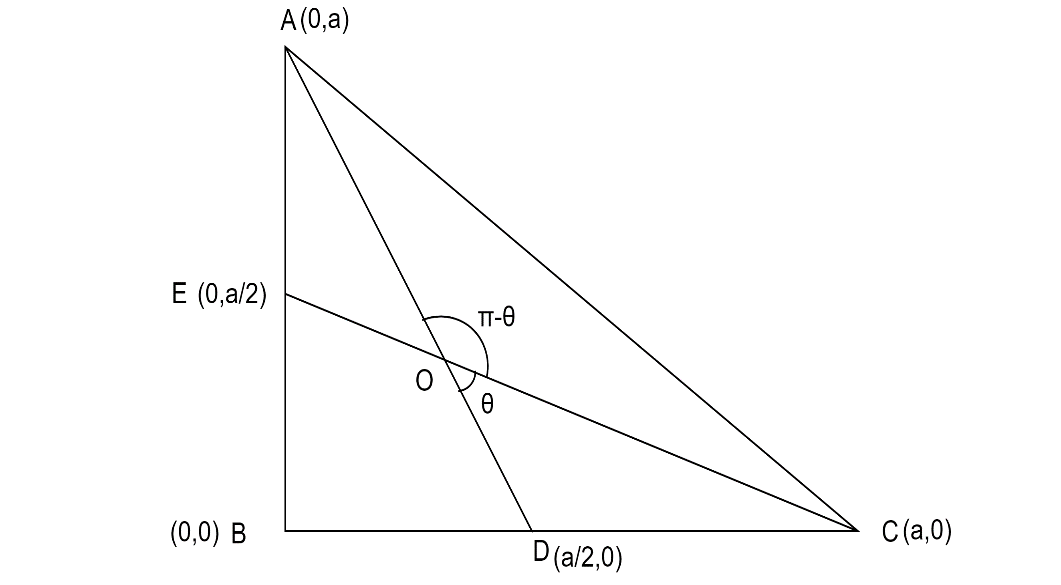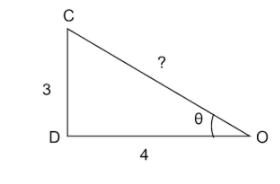Answer
425.7k+ views
Hint: The first step is to find the slope of the two medians. By using the angle between the two lines formula, we can find the tangent angle. In question they have asked the cosine of the obtuse angle, so we have to calculate accordingly by using tan theta.
Formula used
The Pythagoras theorem is used in this question which states that the square of the length of hypotenuse is equal to the sum of the square of the other two sides.
The slope of the line is,
\[{\text{m1 = }}\dfrac{{{\text{y2}} - {\text{y1}}}}{{{\text{x2}} - {\text{x1}}}}\]
The angle between two lines of the triangle is,
\[{\text{tan}}\theta = \left| {\dfrac{{{\text{m1}} - {\text{m2}}}}{{{\text{1 + m1m2}}}}} \right|\]
Where,
\[{\text{x1,x2}}\] be the axis of the \[{\text{x}}\] formed by the line segment
\[{\text{y1,y2}}\] be the axis of the \[{\text{y}}\] formed by the line segment
\[{\text{m1,m2}}\] be the gradient of the two lines
Complete step-by-step answer:
The data given in the question is,
The isosceles right-angled triangle \[\vartriangle {\text{ABC}}\] is drawn below,
Let \[{\text{a}}\] be the length of the two sides of the isosceles right-angled triangle

\[{\text{AD}}\] and \[{\text{CE}}\] are the medians drawn from the vertices which intersect at the point \[{\text{O}}\]
\[\theta \] be the angle made by the medians which forms the triangle \[\vartriangle {\text{DOC}}\]
\[\pi - \theta \] be the angle made by the medians which forms the triangle \[\vartriangle {\text{AOC}}\]
To find the cosine of the obtuse angle,
Step 1
The slope of the median \[{\text{CE}}\] in the above triangle be ,
\[{\text{m1 = }}\dfrac{{{\text{y2}} - {\text{y1}}}}{{{\text{x2}} - {\text{x1}}}}\]
While substituting the values of \[{\text{x and y}}\] axes in the above we get,
\[{\text{m1 = }}\dfrac{{\dfrac{{\text{a}}}{2} - 0}}{{0 - {\text{a}}}}\]
While solving we get the slope of the median \[{\text{CE}}\],
\[{\text{m1 = }}\dfrac{{ - 1}}{2}\]
The slope of the median \[{\text{AD}}\] in the above triangle be ,
\[{\text{m2 = }}\dfrac{{{\text{y2}} - {\text{y1}}}}{{{\text{x2}} - {\text{x1}}}}\]
While substituting the values of \[{\text{x and y}}\] axes in the above we get,
\[{\text{m2 = }}\dfrac{{0 - {\text{a}}}}{{\dfrac{{\text{a}}}{2} - 0}}\]
While solving we get the slope of the median \[{\text{AD}}\],
\[{\text{m2 = }} - 2\]
Step 2
The angle between the two lines of the triangle is,
\[{\text{tan}}\theta = \left| {\dfrac{{{\text{m1}} - {\text{m2}}}}{{{\text{1 + m1m2}}}}} \right|\]
While substituting the gradient values in the above we get,
\[{\text{tan}}\theta = \left| {\dfrac{{\dfrac{{ - 1}}{2} - ( - {\text{2)}}}}{{{\text{1 + (}}\dfrac{{ - 1}}{2}{\text{)(}} - {\text{2)}}}}} \right|\]
While solving the above we get,
\[{\text{tan}}\theta = \left| {\dfrac{{\dfrac{3}{2}}}{2}} \right|\]
The tangent angle between two medians is,
\[{\text{tan}}\theta = \left| {\dfrac{3}{4}} \right| = \dfrac{3}{4}\]
Step 3
By the question, we have to find the cosine of the obtuse angle,

The above triangle is drawn by using \[{\text{tan}}\theta = \dfrac{3}{4}\] since \[{\text{tan}}\theta = \dfrac{{{\text{opposite side}}}}{{{\text{adjacent side}}}}\]
By using the pythagoras theorem we will be able to find the third side of the above triangle,
\[{\text{O}}{{\text{C}}^2} = {\text{O}}{{\text{D}}^2}{\text{ + D}}{{\text{C}}^2}\]
By substituting the values, we get,
\[{\text{O}}{{\text{C}}^2} = {4^2}{\text{ + }}{{\text{3}}^2}\]
While solving the above we get,
\[{\text{O}}{{\text{C}}^2} = 16{\text{ + 9}}\]
By adding we get.
\[{\text{O}}{{\text{C}}^2} = 25\]
By solving we get,
\[{\text{OC}} = \sqrt {25} \]
The third side(hypotenuse) of the above triangle will be,
\[{\text{OC}} = 5\]
Then the cosine of the triangle will be,
\[{\text{cos}}\theta = \dfrac{{{\text{adjacent side}}}}{{{\text{hypotenuse}}}}\]
By substituting the values, we get,
\[{\text{cos}}\theta = \dfrac{4}{5}\]
But the angle formed by the cosine of the obtuse angle will be \[\pi - \theta \]
\[{\text{cos(}}\pi - \theta {\text{)}} = - \cos \theta \]
By substituting the cos theta value, we get,
\[{\text{cos(}}\pi - \theta {\text{)}} = - \dfrac{4}{5}\]
$\therefore $The required cosine angle of the obtuse angle is \[ - \dfrac{4}{5}\].
Hence, the cosine of the obtuse angle formed by medians drawn from the vertices of the acute angles of an isosceles right angled triangle is \[ - \dfrac{4}{5}\] .
Thus, the option \[({\text{D}})\] is correct.
Note: The angle of any straight line will be \[{180^ \circ }{\text{or }}\pi \]. Since the medians drawn are straight lines, it forms an angle of \[{180^ \circ }{\text{or }}\pi \] . That is the reason, we subtract \[\pi \] and \[\theta \] in the first triangle . The two medians intersect to form the centroid of the triangle.
Formula used
The Pythagoras theorem is used in this question which states that the square of the length of hypotenuse is equal to the sum of the square of the other two sides.
The slope of the line is,
\[{\text{m1 = }}\dfrac{{{\text{y2}} - {\text{y1}}}}{{{\text{x2}} - {\text{x1}}}}\]
The angle between two lines of the triangle is,
\[{\text{tan}}\theta = \left| {\dfrac{{{\text{m1}} - {\text{m2}}}}{{{\text{1 + m1m2}}}}} \right|\]
Where,
\[{\text{x1,x2}}\] be the axis of the \[{\text{x}}\] formed by the line segment
\[{\text{y1,y2}}\] be the axis of the \[{\text{y}}\] formed by the line segment
\[{\text{m1,m2}}\] be the gradient of the two lines
Complete step-by-step answer:
The data given in the question is,
The isosceles right-angled triangle \[\vartriangle {\text{ABC}}\] is drawn below,
Let \[{\text{a}}\] be the length of the two sides of the isosceles right-angled triangle

\[{\text{AD}}\] and \[{\text{CE}}\] are the medians drawn from the vertices which intersect at the point \[{\text{O}}\]
\[\theta \] be the angle made by the medians which forms the triangle \[\vartriangle {\text{DOC}}\]
\[\pi - \theta \] be the angle made by the medians which forms the triangle \[\vartriangle {\text{AOC}}\]
To find the cosine of the obtuse angle,
Step 1
The slope of the median \[{\text{CE}}\] in the above triangle be ,
\[{\text{m1 = }}\dfrac{{{\text{y2}} - {\text{y1}}}}{{{\text{x2}} - {\text{x1}}}}\]
While substituting the values of \[{\text{x and y}}\] axes in the above we get,
\[{\text{m1 = }}\dfrac{{\dfrac{{\text{a}}}{2} - 0}}{{0 - {\text{a}}}}\]
While solving we get the slope of the median \[{\text{CE}}\],
\[{\text{m1 = }}\dfrac{{ - 1}}{2}\]
The slope of the median \[{\text{AD}}\] in the above triangle be ,
\[{\text{m2 = }}\dfrac{{{\text{y2}} - {\text{y1}}}}{{{\text{x2}} - {\text{x1}}}}\]
While substituting the values of \[{\text{x and y}}\] axes in the above we get,
\[{\text{m2 = }}\dfrac{{0 - {\text{a}}}}{{\dfrac{{\text{a}}}{2} - 0}}\]
While solving we get the slope of the median \[{\text{AD}}\],
\[{\text{m2 = }} - 2\]
Step 2
The angle between the two lines of the triangle is,
\[{\text{tan}}\theta = \left| {\dfrac{{{\text{m1}} - {\text{m2}}}}{{{\text{1 + m1m2}}}}} \right|\]
While substituting the gradient values in the above we get,
\[{\text{tan}}\theta = \left| {\dfrac{{\dfrac{{ - 1}}{2} - ( - {\text{2)}}}}{{{\text{1 + (}}\dfrac{{ - 1}}{2}{\text{)(}} - {\text{2)}}}}} \right|\]
While solving the above we get,
\[{\text{tan}}\theta = \left| {\dfrac{{\dfrac{3}{2}}}{2}} \right|\]
The tangent angle between two medians is,
\[{\text{tan}}\theta = \left| {\dfrac{3}{4}} \right| = \dfrac{3}{4}\]
Step 3
By the question, we have to find the cosine of the obtuse angle,

The above triangle is drawn by using \[{\text{tan}}\theta = \dfrac{3}{4}\] since \[{\text{tan}}\theta = \dfrac{{{\text{opposite side}}}}{{{\text{adjacent side}}}}\]
By using the pythagoras theorem we will be able to find the third side of the above triangle,
\[{\text{O}}{{\text{C}}^2} = {\text{O}}{{\text{D}}^2}{\text{ + D}}{{\text{C}}^2}\]
By substituting the values, we get,
\[{\text{O}}{{\text{C}}^2} = {4^2}{\text{ + }}{{\text{3}}^2}\]
While solving the above we get,
\[{\text{O}}{{\text{C}}^2} = 16{\text{ + 9}}\]
By adding we get.
\[{\text{O}}{{\text{C}}^2} = 25\]
By solving we get,
\[{\text{OC}} = \sqrt {25} \]
The third side(hypotenuse) of the above triangle will be,
\[{\text{OC}} = 5\]
Then the cosine of the triangle will be,
\[{\text{cos}}\theta = \dfrac{{{\text{adjacent side}}}}{{{\text{hypotenuse}}}}\]
By substituting the values, we get,
\[{\text{cos}}\theta = \dfrac{4}{5}\]
But the angle formed by the cosine of the obtuse angle will be \[\pi - \theta \]
\[{\text{cos(}}\pi - \theta {\text{)}} = - \cos \theta \]
By substituting the cos theta value, we get,
\[{\text{cos(}}\pi - \theta {\text{)}} = - \dfrac{4}{5}\]
$\therefore $The required cosine angle of the obtuse angle is \[ - \dfrac{4}{5}\].
Hence, the cosine of the obtuse angle formed by medians drawn from the vertices of the acute angles of an isosceles right angled triangle is \[ - \dfrac{4}{5}\] .
Thus, the option \[({\text{D}})\] is correct.
Note: The angle of any straight line will be \[{180^ \circ }{\text{or }}\pi \]. Since the medians drawn are straight lines, it forms an angle of \[{180^ \circ }{\text{or }}\pi \] . That is the reason, we subtract \[\pi \] and \[\theta \] in the first triangle . The two medians intersect to form the centroid of the triangle.
Recently Updated Pages
What are the figures of speech in the poem Wind class 11 english CBSE

Write down 5 differences between Ntype and Ptype s class 11 physics CBSE

Two tankers contain 850 litres and 680 litres of petrol class 10 maths CBSE

What happens when eggshell is added to nitric acid class 12 chemistry CBSE

Why was Kamaraj called as Kingmaker class 10 social studies CBSE

What makes elections in India democratic class 11 social science CBSE

Trending doubts
Which are the Top 10 Largest Countries of the World?

Fill the blanks with the suitable prepositions 1 The class 9 english CBSE

Distinguish between fundamental units and derived class 11 physics CBSE

Difference between Prokaryotic cell and Eukaryotic class 11 biology CBSE

Give 10 examples for herbs , shrubs , climbers , creepers

Differentiate between homogeneous and heterogeneous class 12 chemistry CBSE

Dynesec the unit of A Momentum B Force C Work D Angular class 11 physics CBSE

Change the following sentences into negative and interrogative class 10 english CBSE

The Equation xxx + 2 is Satisfied when x is Equal to Class 10 Maths



